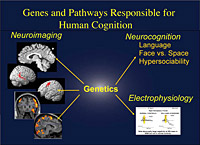Laboratory for Cognitive Neuroscience
Established in 1970, the Salk Institute's Laboratory for Cognitive Neuroscience (LCN) is dedicated to the study of the neural and genetic underpinnings of language and cognition. Our approach brings together experts in diverse fields to study these complex issues. The LCN organizes its resources into two research foci: Linking Gene, Brain, and Cognition, and Language, Modality and the Brain.
Linking Gene, Brain, and Cognition: Behavioral Neurogenetics
 Headed by LCN Director, Dr. Ursula Bellugi,
this research is designed to increase our understanding of genetically based disorders, to investigate the consequences of genetic alterations on the development of the brain, and to explore the resulting alteration of cognitive capabilities. We have developed a broad multidisciplinary program that allows us to identify specific networks of interconnected brain regions - cortical and subcortical - underlying cognitive functions such as language and spatial cognition. Such a comprehensive approach, including neurocognition, neurophysiology, neuromorphology, brain cytoarchitectonics and molecular genetics, holds the potential to maximize our understanding of the neural bases of cognition and provides critical clues to the nature of both normal mental operations and the genetically based differences that occur in specific syndromes affecting higher cortical functions. Moreover, this research aims to identify new opportunities for treating and preventing diverse mental disorders. Learn more...
Headed by LCN Director, Dr. Ursula Bellugi,
this research is designed to increase our understanding of genetically based disorders, to investigate the consequences of genetic alterations on the development of the brain, and to explore the resulting alteration of cognitive capabilities. We have developed a broad multidisciplinary program that allows us to identify specific networks of interconnected brain regions - cortical and subcortical - underlying cognitive functions such as language and spatial cognition. Such a comprehensive approach, including neurocognition, neurophysiology, neuromorphology, brain cytoarchitectonics and molecular genetics, holds the potential to maximize our understanding of the neural bases of cognition and provides critical clues to the nature of both normal mental operations and the genetically based differences that occur in specific syndromes affecting higher cortical functions. Moreover, this research aims to identify new opportunities for treating and preventing diverse mental disorders. Learn more...
Language, Modality, and the Brain
 Headed by Dr. Ursula Bellugi and Dr. Gregory Hickok, the focus of this research is to obtain a greater understanding of how language and cognition are represented in the brain. Sign languages provide a powerful tool for investigating the neurobiology and cognitive architecture of human language. For perception, these languages depend upon high-level vision and motion processing systems; for production, they require the integration of motor systems involving the hands and face. What impact does this different biological base have for the nature of on-line language processing? How does it affect nonlinguistic cognitive structure and processing? Are the same neural systems involved? Our studies address these questions by investigating cognitive functions implicated in the processing of American Sign Language (ASL) and by investigating the neural basis of cognitive and linguistic functions using both lesion and functional imaging techniques. We also address the neural systems underlying language and other domains of cognition between deaf and hearing subjects. These studies make use of methods of brain imaging, including event related potentials (ERP), magnetic resonance imaging (MRI), functional MRI, and positron emission tomography (PET). The capacity of brain systems to subserve language, regardless of modality, is a striking example of neuronal plasticity. Learn more...
Headed by Dr. Ursula Bellugi and Dr. Gregory Hickok, the focus of this research is to obtain a greater understanding of how language and cognition are represented in the brain. Sign languages provide a powerful tool for investigating the neurobiology and cognitive architecture of human language. For perception, these languages depend upon high-level vision and motion processing systems; for production, they require the integration of motor systems involving the hands and face. What impact does this different biological base have for the nature of on-line language processing? How does it affect nonlinguistic cognitive structure and processing? Are the same neural systems involved? Our studies address these questions by investigating cognitive functions implicated in the processing of American Sign Language (ASL) and by investigating the neural basis of cognitive and linguistic functions using both lesion and functional imaging techniques. We also address the neural systems underlying language and other domains of cognition between deaf and hearing subjects. These studies make use of methods of brain imaging, including event related potentials (ERP), magnetic resonance imaging (MRI), functional MRI, and positron emission tomography (PET). The capacity of brain systems to subserve language, regardless of modality, is a striking example of neuronal plasticity. Learn more...





